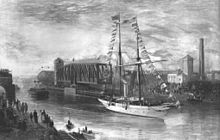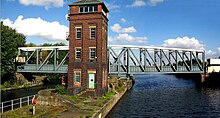Manchester Ship Canal
The Manchester Ship Canal is a 58 km long canal in the north west of England . Starting south of Liverpool at the mouth of the River Mersey in the Irish Sea , it follows the course of the river and the River Irwell to Manchester . The most striking structure on the canal is the Barton Swing Aqueduct .
history

The Manchester Ship Canal took over the function of the Mersey and Irwell Navigation and the Bridgewater Canal as a shipping link from Manchester to the Irish Sea since the 18th century . However, these two channels were only navigable by comparatively small river boats . When in the second half of the 19th century a long-lasting depression led to the decline of Manchester's industry, the idea of giving seagoing ships direct access to the city was developed. The canal should enable Manchester to become a direct competitor of Liverpool, which made the transport of goods with small ships to and from Manchester unattractive with high port fees.
Resistance on the part of Liverpool let the necessary parliamentary resolution fail in 1882 and 1884 and only the third draft could pass parliament in 1885. Only now could the financing of the planned canal begin. The parliamentary decision mandated a capital of Kapital 8 million for the canal company and provided for a period of two years in which this money was to be raised. However, the competition from Liverpool and the high costs deterred potential investors. In 1887, a new parliamentary resolution finally made it possible to divide the capital into preferred and ordinary shares . The Barings Bank and the Rothschild Bank could find within a short time investors for preferred shares. So on November 11, 1887, the groundbreaking ceremony for the construction of the canal took place. After four years the capital of ₤ 8 million had been used up, but the canal was not yet completed. The canal company turned to Manchester City Council to guarantee further funding. The city took on the task of raising the necessary money and in return obtained a majority in the management of the canal company.
Edward Leader Williams was the engineer responsible for the construction, the Barton Swing Aqueduct designed by him is still a technically important structure as the only swing trough bridge in the world.
The canal was completed on December 7, 1893 after six years of construction and opened to traffic on January 1, 1894. The official opening by Queen Victoria took place during a visit to Manchester on May 21, 1894.
The canal was designed to allow the largest ships to pass through at the time of construction and made the port of Manchester the third largest seaport in England, although the city is 40 miles from the sea. The largest volume of goods on the canal was recorded in 1958. Since then, trade has steadily declined, also because today's ocean-going vessels are often too big to pass through. The owner Peel Ports ( Peel Holdings ) plans to expand the canal to revive shipping traffic.
Routing
The canal runs from its western end at Eastham south of the Mersey past Ellesmere Port . Between Rixton, east of the Thelwall Viaduct on the M6 , and Irlam, it follows the Mersey. At the confluence of the Rivers Mersey and Irwell at Irlam, the canal follows the old course of the River Irwell all the way to Manchester. A height difference of 18 m in total is overcome with five locks .
construction
The following key figures were assumed in the planning and early execution stages:
- Length: 57 km
- Water level width: maximum 52 m
- Sole width: 36.5 m
- Minimum water depth 7.9 m
- Difference in water level: 18 m
- Locks: four (each a maximum of 180 m by 24 m); Material: green heart wood
- Locks and quay walls: approx. 900,000 m³ concrete; 120,000 m³ of brickwork and 150,000 m³ of other masonry
- Total excavation (canal plus docks): 35 million m³, of which approx. 7 million m³ rock
- Construction machinery (puncture): approx. 100 excavators (respective average daily output: 500 m³ to 1,400 m³)
- Material transport: 173 locomotives, 6,300 wagons on 360 km of working tracks
- Auxiliary machines: 194 steam cranes, 209 steam pumps, 182 various steam engines
- Energy consumption: approx. 10,000 tons of coal per month
- Cutting depth: 20 m (on a short length), 16.5 m (on a length of 2.4 km)
- Slope of the slopes: 1: 1 to 1: 2; in the rocky areas up to 10: 1
- Workforce (1890): 15,600 people
Other facilities
For the transport of goods between the warehouses and the quays, the canal company operated the Manchester Ship Canal Railway , which was a private railway until it was closed in April 2009.
Until 1993, the canal company maintained the Manchester Ship Canal Police , which had police power along the stretch of the canal over a width of 1.5 km on both sides of the canal.
literature
- Sir Bosdin Leech: History of the Manchester Canal. From its inception to its completion . (English). Volume I. Sherratt & Hughes, Manchester / London 1907.
- -: History of the Manchester Canal. From its inception to its completion . (English). Volume II. Sherratt & Hughes, Manchester / London 1907.
- David Elystan Owen: The Manchester Ship Canal . (English). Manchester University Press, Manchester 1983, ISBN 0-7190-0864-6 .
- David Elystan Owen: Canals to Manchester . (English). Palgrave Macmillan, Houndmills, Basingstoke (Hampshire) 1988, ISBN 0-7190-2631-8 .
- Ian Harford: Manchester and its Ship Canal Movement. Class, work and politics in late-Victorian England . (English). Ryburn Publishing, Straffordshire 1994, ISBN 1-85331-075-1 .
- Edward Gray: Manchester Ship Canal . (English). Sutton Publishing, Stroud 1997, ISBN 0-7509-1459-9 .
- Manchester Ship Canal Police . (English). In: Magazine of the Police Memorabilia Collectors Club . No. 149, August 13, 2010.
- Karina Karadensky: The Salford Quays . In: -: Contemporary cultural buildings as “flagships” of urban regeneration using the example of Salford Quays in Greater Manchester . Thesis. University of Vienna, Vienna 2011, pp. 38–41. - Full text online (PDF; 7 MB) .
Web links
- The excavators of the Manchester Canal. In: Weekly of the Austrian Association of Engineers and Architects , year 1889, No. 43/1889 (XIV. Year), p. 343. (Online at ANNO ). .
- Manchester Ship Canal a brief History (PDF; 402 kB)
- Bringing the Sea to Manchester - The Need for a 'Big Ditch' at The Transport Archive
Individual evidence
- ^ From the IV. International Inland Navigation Congress in Manchester. (...) Via the Manchester Ship Canal (...). In: Weekly of the Austrian Association of Engineers and Architects , year 1890, No. 36/1890 (XV. Year), p. 309, center left. (Online at ANNO ). .



